Salute (pyrotechnics)
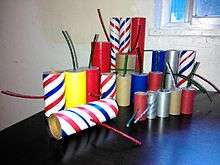
In pyrotechnics, a salute is an explosive device primarily designed to make a loud bang with a very intense flash of light. Salutes are made from flash powder, most commonly a 70:30 mixture of potassium perchlorate and dark aluminium powder.[1] Titanium flakes may be added as a special effect 5% to the total mix. A salute may be fired on the ground or launched from a mortar as a shell (aerial salute) or (aerial bomb). Salutes are one of the more dangerous type of fireworks. "Mortar tubes" used to launch aerial salute shells in commercial firework displays vary from 1.75 inch to 8 inch diameter. The shells they fire can come in ball or canister form. Ground salutes most commonly come in a paper tube but may also come round as a (cherry bomb) or triangle as a (triangle cracker). Salutes may have aluminum, antimony, titanium or other metals. Flash Salutes are much louder when they are 2/3 full of composition allowing for 100% heat/gas conversion/expansion before the chamber bursts open. All commercial salutes are made this way for this reason. The most common aluminum is "Dark Pyro Al" or "Bright Pyro Al". Dark Al's preferred are Dark German Al or Indian Blackhead Al - 3 Micron. Both are known for being the most violent/reactive/explosive. Bright Flake Aluminum -325 mesh is a cheaper alternative but is not as loud/explosive. "Flake Aluminum" is the only pyro aluminum used for flash powder. Spherical Aluminum will not work. All ground salutes over 50mg and air salutes over 130mg are restricted by the United States Consumer Product Safety Commission (CPSC) and the Child Protection Act of 1966. 99% of all salutes ground and aerial are made with flash powder, but older salutes predating the early 60's carried black powder. These salutes were called "Cannon Crackers". Flash powder is significantly more destructive than black powder (BP). Black powder has a slow enough burn rate to push objects within the blast radius where as flash powder is more prone to destroy anything within its range. This is why gunpowder is the standard for firearms and why black powder salutes need heavy confinement to work.
Comparison to dynamite
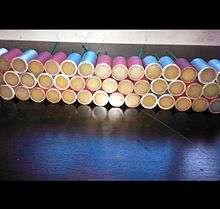
Though news reporters and black-market dealers compare the M-80 to a 1/4 stick of dynamite, the two are nowhere close. For reference; a typical stick of dynamite contains over 10 times more explosive material than an M-80 (35 grams of nitroglycerin versus 3 grams of KClO4 and Al). Nitroglycerin detonates with a shock wave that moves faster than the speed of sound where as flash powder used in salutes or black powder used in fireworks/firearms deflagrate with a shockwave slower than the speed of sound.[2] Detonation and deflagration is the difference between high and low explosive. Quote from pyrouniverse.com: "Another assumption people make is that M-80's have some relation to dynamite; as the terms "quarter-stick" or "M-80 half-stick" are widely used to describe the power of such explosives." All "salutes" have a significantly slower burn rate than high explosives such as nitroglycerin, c4, tannerite, etc . Flash powder is a low explosive. Nitroglycerine is a high explosive.[3]
Cherry Bombs
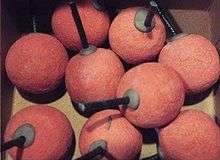
- 1/2" to 5/8" Inner Diameter
- 3/4" to 1" Outer Diameter
- Color: fan posters reveal they came in just about every color that is out there but red still being most common.
- 1 Gram of flash
Also known as kraft salutes, these are made of paper cup sets, coated with several layers of sawdust and animal hide glue (or sodium silicate), often finished with a reddish dye (Sudan Red).[4] The process of coating Kraft salute casings in order to make them round is called panning. The glued casings are tumbled with sawdust while sodium silicate solution is slowly added to the pan. Historically, the core contained a perchlorate, sulfur, and antimony sulfide mixture. Some manufacturers added aluminum and or Magnesium Dioxide to this mixture. As sighted by "How to Make Exploding Fireworks by, John Donner", "KENT FIREWORKS" added a small red or green star to their mixture for a color effect. Wax-coated drill bits were used for safety purposes when drilling the fuse hole. KENT FIREWORKS CHERRY BOMB FORMULA: Potassium Perchlorate (KClO4) 50%, Sulfur (S) 7.5%, Antimony Trisulfide (SbS3) 17.5%, German Black Aluminum (Al) 25%, Manganese Dioxide (MnO2) +0.5%[5]
BLOWOUT: when flash powder is packed so tight in a confined space that it does not have enough time to convert itself into 100% heat/gas before "combustion" thus blowing out unexploded powder into thin air. This can also be referred to as "premature combustion". Blowout can occur under a number of scenarios: Scenario 1) when the tube is filled to its max and or packed down tightly. Scenario 2) when the firecracker tube exceeds its diameter in length more than 4x and doesn't have its fuse placed in the middle to compensate the length. A 1/3 air space is the pyro standard in all pro salutes.
OTHER FLASH FORMULAS
FORMULA #1 : 50% KNO3 Potassium Nitrate/30% S Sulfur/20% Bright Al Aluminum Comments: This is a relatively safe flash composition. Burns with a brilliant white light in an open tube, or when unconfined. When well confined, it produces a very deep report and a short but intense flash. Thick end plugs required.
FORMULA #2 : 50% KClO4 Potassium Perchlorate/ 27% Sulfur powder/ 23% Dark German or Indian aluminum powder (Anything under 4 micron for BEST results). Comments: This is a relatively safe formula that is more powerful than the standard formula but should not be used by first time flash producers, at least being proficient is best. This produces a low/medium pitched report with a nice pressure wave. Thick end plugs may or may not be a requirement depending on the manufacturer of this formula.
FORMULA #3 : 70% KClO4 Potassium Perchlorate/ 30% Dark German Aluminum or Indian Aluminum powder. The easiest flash powder formula to make. A very standard pyrotechnic composition used in the industry of fireworks. Thick end plugs are never a requirement with this composition.
Silver Salutes
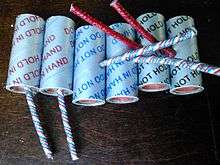
Silver Salutes
- 1-1/2" Long
- 1/2" inner diameter
- 5/8" Outer Diameter
- Color: Silver
- 1.5 Grams of flash
- Side or Top fused
Silver Salutes were typically side fused by every company during the time of their making; all excluding Millar Fireworks Co. during the 1940's. A label with six to ten warnings reading "DO NOT HOLD IN HAND" were wrapped in a continuous spiral with black, blue or maroon color text. Font style and text size varied as well. The hole punch was always made a little smaller than the fuse for a tight fit every time. Some even added glue or a black powder slurry to make an airtight fit around the fuse hole. Caution: beware of vintage versions plugged with sodium silicate /calcium carbonate cement. They are known to leak powder and can ignite in face when attempting to light. Reinforcement with hot glue advised.[5]
BLOWOUT: when flash powder is packed so tight in a confined space that it does not have enough time to convert itself into 100% heat/gas before "combustion" thus blowing out unexploded powder into thin air. This can also be referred to as "premature combustion". Blowout can occur under a number of scenarios: Scenario 1) when the tube is filled to its max and or packed down tightly. Scenario 2) when the firecracker tube exceeds its diameter in length more than 4x and doesn't have its fuse placed in the middle to compensate the length. A 1/3 air space is the pyro standard in all pro salutes.
FORMULA #1 : 50% KNO3 Potassium Nitrate/30% S Sulfur/20% Bright Al Aluminum Comments: This is a relatively safe flash composition. Burns with a brilliant white light in an open tube, or when unconfined. When well confined, it produces a very deep report and a short but intense flash. Thick end plugs required.
FORMULA #2 : 50% KClO4 Potassium Perchlorate/ 27% Sulfur powder/ 23% Dark German or Indian aluminum powder (Anything under 4 micron for BEST results). Comments: This is a relatively safe formula that is more powerful than the standard formula but should not be used by first time flash producers, at least being proficient is best. This produces a low/medium pitched report with a nice pressure wave. Thick end plugs may or may not be a requirement depending on the manufacturer of this formula.
FORMULA #3 : 70% KClO4 Potassium Perchlorate/ 30% Dark German Aluminum or Indian Aluminum powder. The easiest flash powder formula to make. A very standard pyrotechnic composition used in the industry of fireworks. Thick end plugs are never a requirement with this composition.
END PLUGS : paper, plastic, bentonite clay, amber hot glue or white hot glue
Ash Cans

- 1-1/2" Long
- 5/8" inner diameter
- 3/4" outer diameter
- Color: Silver, Red, Tan or Yellow
- 3 Grams of flash
- Top fused
Same power as an M-80
BLOWOUT: when flash powder is packed so tight in a confined space that it does not have enough time to convert itself into 100% heat/gas before "combustion" thus blowing out unexploded powder into thin air. This can also be referred to as "premature combustion". Blowout can occur under a number of scenarios: Scenario 1) when the tube is filled to its max and or packed down tightly. Scenario 2) when the firecracker tube exceeds its diameter in length more than 4x and doesn't have its fuse placed in the middle to compensate the length. A 1/3 air space is the pyro standard in all pro salutes.
FORMULA #1 : 50% KNO3 Potassium Nitrate/30% S Sulfur/20% Bright Al Aluminum Comments: This is a relatively safe flash composition. Burns with a brilliant white light in an open tube, or when unconfined. When well confined, it produces a very deep report and a short but intense flash. Thick end plugs required.
FORMULA #2 : 50% KClO4 Potassium Perchlorate/ 27% Sulfur powder/ 23% Dark German or Indian aluminum powder (Anything under 4 micron for BEST results). Comments: This is a relatively safe formula that is more powerful than the standard formula but should not be used by first time flash producers, at least being proficient is best. This produces a low/medium pitched report with a nice pressure wave. Thick end plugs may or may not be a requirement depending on the manufacturer of this formula.
FORMULA #3 : 70% KClO4 Potassium Perchlorate/ 30% Dark German Aluminum or Indian Aluminum powder. The easiest flash powder formula to make. A very standard pyrotechnic composition used in the industry of fireworks. Thick end plugs are never a requirement with this composition.
END PLUGS : paper, plastic, bentonite clay, amber hot glue or white hot glue
M-80's
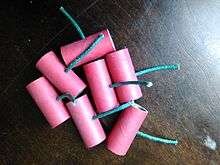
Civilian M-80
- 1-1/2" Long
- 9/16" Inner Diameter
- 11/16" Outer Diameter
- Color: Red
- 3 Grams of flash
- Side fused
Military M-80
- 1-1/2" Long
- 5/8" Inner Diameter
- 3/4" Outer Diameter
- Color: Tan
- 5.2 grams of flash
- Side fused
1.4 Consumer Fireworks version
- 1-1/2" Long
- 9/16" Inner Diameter
- 11/16" Outer Diameter
- Color: Variable
- 50 milligrams of flash
- Side or top fused
1.4 Consumer Firework versions
These contain no more than 50 milligrams of flash powder and are available where ever 1.4 consumer fireworks are sold. Typical labels: "M-60, M-98, M-90, M-150 or M-600" with very descriptive warning labels. These come in a variety of colors. Some are meant to look like M-80's or Silver Salutes but are no where near them in power. They hold the same dimension.... 1-1/2"x 9/16"x 1/16" only to attract buyers. Here is a fake M-80 carrying a small lady finger surrounded in bentonite: Very clever:

(MILITARY M-80 VS CIVILIAN M-80) Originally the M-80 was a military training device designed to simulate small arms fire in basic training. The "M-80's" designation was a military product identification code number. The U.S. government contracted with several fireworks makers to produce these hefty salutes. Military issue M-80's are made from a plain brown craft paper tube 1–1/2" long and 5/8" diameter, fitted with a thick stiff, green Visco fuse and packaged in boxes of 50. Each Salute bears the words "M-80 Firecracker" and the date of manufacture "4-64". Careful dissection reveals that each firecracker is double plugged at each end with a paper end plug and end disk. Military M-80's packed a full load of 80 grains which is equivalent to 5.2 grams of flash powder. "M" for Military and "80" for 80 grains. These differ from most flash salutes, which function optimally with some airspace and loose powder. Perhaps this was done because of some government specification that had little to do with performance or perhaps they knew something others did not. After World War II, the M-80 was marketed as a fireworks item for civilian use. The first ones on the market were war surplus. When some of the fireworks dealers saw how well they were received by the public, they began making civilian copies. These copies were sold by the millions in the 1950s and 1960s. The civilian M-80 had a red tube bearing the words "M-80 FIRECRACKER DO NOT HOLD IN HAND" printed on the outside in bold letters.
In Mexico, these salutes are called "Barrenos".
BLOWOUT: when flash powder is packed so tight in a confined space that it does not have enough time to convert itself into 100% heat/gas before "combustion" thus blowing out unexploded powder into thin air. This can also be referred to as "premature combustion". Blowout can occur under a number of scenarios: Scenario 1) when the tube is filled to its max and or packed down tightly. Scenario 2) when the firecracker tube exceeds its diameter in length more than 4x and doesn't have its fuse placed in the middle to compensate the length. A 1/3 air space is the pyro standard in all pro salutes.
MILITARY FORMULA:
- potassium perchlorate KClO
4 64% - bright pyro aluminum Al 22.5%
- sulfur S 10%
- antimony sulfide Sb
2S
3 3.5%
FORMULA #1 : 50% KNO3 Potassium Nitrate/30% S Sulfur/20% Bright Al Aluminum Comments: This is a relatively safe flash composition. Burns with a brilliant white light in an open tube, or when unconfined. When well confined, it produces a very deep report and a short but intense flash. Thick end plugs required.
FORMULA #2 : 50% KClO4 Potassium Perchlorate/ 27% Sulfur powder/ 23% Dark German or Indian aluminum powder (Anything under 4 micron for BEST results). Comments : This is a relatively safe formula that is more powerful than the standard formula but should not be used by first time flash producers, at least being proficient is best. This produces a low/medium pitched report with a nice pressure wave. Thick end plugs may or may not be a requirement depending on the manufacturer of this formula.
FORMULA #3 : 70% KClO4 Potassium Perchlorate/ 30% Dark German Aluminum or Indian Aluminum powder. This is most likely the easiest flash powder formula to make. It is a very standard salute composition used in the pyrotechnics industry. Thick end plugs and heavy containment are not required with this composition.
END PLUGS : paper, plastic, bentonite clay, amber hot glue or white hot glue
Super M-80
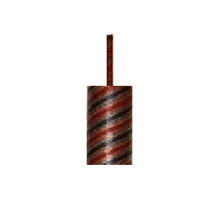
- 3" Long
- 9/16" Inner Diameter
- 11/16" Outer Diameter
- Color: Glossy Red
- 6 grams of flash
- Side fused
- 1-3/4" Long
- 3/4" Inner Diameter
- 1" Outer Diameter
- Color: red/gold/blue, barber pole or red
- 6 grams of flash
- Top fused
Double the composition and double the size of an M-80.
BLOWOUT: when flash powder is packed so tight in a confined space that it does not have enough time to convert itself into 100% heat/gas before "combustion" thus blowing out unexploded powder into thin air. This can also be referred to as "premature combustion". Blowout can occur under a number of scenarios: Scenario 1) when the tube is filled to its max and or packed down tightly. Scenario 2) when the firecracker tube exceeds its diameter in length more than 4x and doesn't have its fuse placed in the middle to compensate the length. A 1/3 air space is the pyro standard in all pro salutes.
FORMULA #1 : 50% KNO3 Potassium Nitrate/30% S Sulfur/20% Bright Al Aluminum Comments: This is a relatively safe flash composition. Burns with a brilliant white light in an open tube, or when unconfined. When well confined, it produces a very deep report and a short but intense flash. Thick end plugs required.
FORMULA #2 : 50% KClO4 Potassium Perchlorate/ 27% Sulfur powder/ 23% Dark German or Indian aluminum powder (Anything under 4 micron for BEST results). Comments: This is a relatively safe formula that is more powerful than the standard formula but should not be used by first time flash producers, at least being proficient is best. This produces a low/medium pitched report with a nice pressure wave. Thick end plugs may or may not be a requirement depending on the manufacturer of this formula.
FORMULA #3 : 70% KClO4 Potassium Perchlorate/ 30% Dark German Aluminum or Indian Aluminum powder. The easiest flash powder formula to make. A very standard pyrotechnic composition used in the industry of fireworks. Thick end plugs are never a requirement with this composition.
END PLUGS : paper, plastic, bentonite clay, amber hot glue or white hot glue
M-100's
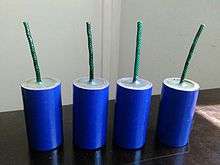
- 2" Long
- 3/4" Inner Diameter
- 1" Outer Diameter
- Color: Blue, Red, RWB or Tan
- 7 grams of flash
- Barber pole versions may hold up to 10 grams of flash
- Top or side fused
Popularly referred to as the "M-1000" in California but still referred to as "M-100" everywhere else in the United States. Not to be confused with "M-1000 / Full Stick". For details please click on "Full Stick M-1000" in the context box above. "California M-1000's" are more popular than the M-80 due to their water resistant quality, high power, affordability and pocket size.
BLOWOUT: when flash powder is packed so tight in a confined space that it does not have enough time to convert itself into 100% heat/gas before "combustion" thus blowing out unexploded powder into thin air. This can also be referred to as "premature combustion". Blowout can occur under a number of scenarios: Scenario 1) when the tube is filled to its max and or packed down tightly. Scenario 2) when the firecracker tube exceeds its diameter in length more than 4x and doesn't have its fuse placed in the middle to compensate the length. A 1/3 air space is the pyro standard in all pro salutes.
FORMULA #1 : 50% KNO3 Potassium Nitrate/30% S Sulfur/20% Bright Al Aluminum Comments: This is a relatively safe flash composition. Burns with a brilliant white light in an open tube, or when unconfined. When well confined, it produces a very deep report and a short but intense flash. Thick end plugs required.
FORMULA #2 : 50% KClO4 Potassium Perchlorate/ 27% Sulfur powder/ 23% Dark German or Indian aluminum powder (Anything under 4 micron for BEST results). Comments: This is a relatively safe formula that is more powerful than the standard formula but should not be used by first time flash producers, at least being proficient is best. This produces a low/medium pitched report with a nice pressure wave. Thick end plugs may or may not be a requirement depending on the manufacturer of this formula.
FORMULA #3 : 70% KClO4 Potassium Perchlorate/ 30% Dark German Aluminum or Indian Aluminum powder. The easiest flash powder formula to make. A very standard pyrotechnic composition used in the industry of fireworks. Thick end plugs are never a requirement with this composition.
END PLUGS : paper, plastic, bentonite clay, amber hot glue or white hot glue
Blockbusters
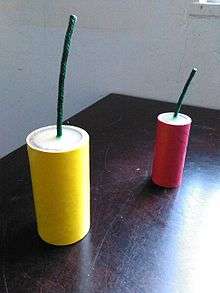
Standard
- 2 1/8" Long
- 3/4" Inner Diameter
- 1" Outer Diameter
- Color: Red
- 1 Gram Titanium Flake
- 7 Grams of flash
- Top fused
Large
- 2-1/2" Long
- 1" Inner Diameter
- 1-1/4" Outer Diameter
- Color: Yellow
- 1 Gram Titanium Flake
- 20 Grams of flash
- Top fused
A Blockbuster is a ground salute but with added titanium otherwise know as a "titanium salute". A "titanium salute", "ti-salute" for short is a flash powder explosive containing small grains of titanium metal. The effect produced is a short and intense shower of golden/white sparks. Blockbusters are most common on the East Coast United States. The larger block busters may resemble a quarter stick of dynamite even though they are not the same thing. For instance, a weight of 20 grams nitroglycerin will cause a lot more destruction than an equal weight of flash powder. Titanium salutes as an effect is most commonly used in professional fireworks with 1.3 labels. The effect will be sent up by a display shell, multi fire cake or rocket. NOTE: more rare ti-salutes will produce a donut ring effect in the air. This is done by coating the inner walls of the cylinder with pyro adhesive before dunking into a bowl of titanium flakes. The tube is then left to dry before adding fuse, flash and glued end plugs. Spiking is not needed for a loud report being that flash will self-contain in quantities as small as 10-20 grams and even 1 gram depending on the mix. Titanium mesh must meet safety codes. Anything larger than flake form is considered a weapon.
BLOWOUT: when flash powder is packed so tight in a confined space that it does not have enough time to convert itself into 100% heat/gas before "combustion" thus blowing out unexploded powder into thin air. This can also be referred to as "premature combustion". Blowout can occur under a number of scenarios: Scenario 1) when the tube is filled to its max and or packed down tightly. Scenario 2) when the firecracker tube exceeds its diameter in length more than 4x and doesn't have its fuse placed in the middle to compensate the length. A 1/3 air space is the pyro standard in all pro salutes.
FORMULA #1 : 50% KNO3 Potassium Nitrate/30% S Sulfur/20% Bright Al Aluminum Comments: This is a relatively safe flash composition. Burns with a brilliant white light in an open tube, or when unconfined. When well confined, it produces a very deep report and a short but intense flash. Thick end plugs required.
FORMULA #2 : 50% KClO4 Potassium Perchlorate/ 27% Sulfur powder/ 23% Dark German or Indian aluminum powder (Anything under 4 micron for BEST results). Comments: This is a relatively safe formula that is more powerful than the standard formula but should not be used by first time flash producers, at least being proficient is best. This produces a low/medium pitched report with a nice pressure wave. Thick end plugs may or may not be a requirement depending on the manufacturer of this formula.
FORMULA #3 : 70% KClO4 Potassium Perchlorate/ 30% Dark German Aluminum or Indian Aluminum powder. The easiest flash powder formula to make. A very standard pyrotechnic composition used in the industry of fireworks. Thick end plugs are never a requirement with this composition.
END PLUGS : paper, plastic, bentonite clay, amber hot glue or white hot glue
Quarter Stick M-250
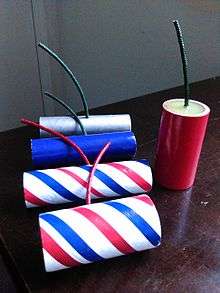
- 3-1/2" Long
- 3/4" Inner Diameter
- 1" Outer Diameter
- Color: RWB, Tan, Silver, Blue, Green or Red
- 15 grams of flash
- Side fused
- 2-1/2" Long
- 1" Inner Diameter
- 1-1/4" Outer Diameter
- Color: RWB, Tan or Red
- 20 Grams of flash
- Top or side fused
A 1/4 Stick is a large ground salute known to resemble a quarter stick of dynamite but comes no where near a true quarter stick of dynamite.
BLOWOUT: when flash powder is packed so tight in a confined space that it does not have enough time to convert itself into 100% heat/gas before "combustion" thus blowing out unexploded powder into thin air. This can also be referred to as "premature combustion". Blowout can occur under a number of scenarios: Scenario 1) when the tube is filled to its max and or packed down tightly. Scenario 2) when the firecracker tube exceeds its diameter in length more than 4x and doesn't have its fuse placed in the middle to compensate the length. A 1/3 air space is the pyro standard in all pro salutes.
FORMULA #1 : 50% KNO3 Potassium Nitrate/30% S Sulfur/20% Bright Al Aluminum Comments: This is a relatively safe flash composition. Burns with a brilliant white light in an open tube, or when unconfined. When well confined, it produces a very deep report and a short but intense flash. Thick end plugs required.
FORMULA #2 : 50% KClO4 Potassium Perchlorate/ 27% Sulfur powder/ 23% Dark German or Indian aluminum powder (Anything under 4 micron for BEST results). Comments: This is a relatively safe formula that is more powerful than the standard formula but should not be used by first time flash producers, at least being proficient is best. This produces a low/medium pitched report with a nice pressure wave. Thick end plugs may or may not be a requirement depending on the manufacturer of this formula.
FORMULA #3 : 70% KClO4 Potassium Perchlorate/ 30% Dark German Aluminum or Indian Aluminum powder. The easiest flash powder formula to make. A very standard pyrotechnic composition used in the industry of fireworks. Thick end plugs are never a requirement with this composition.
END PLUGS : paper, plastic, bentonite clay, amber hot glue or white hot glue
Half Stick M-500
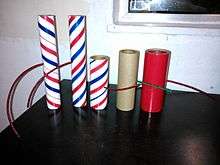
- 6" Long
- 3/4" Inner Diameter
- 1" Outer Diameter
- Color: RWB
- 30 Grams of flash
- Side fused
- 3-1/2" Long
- 1" Inner Diameter
- 1-1/4" Outer Diameter
- Color: RWB
- 30 Grams of flash
- Side fused
- 4" Long
- 1" Inner Diameter
- 1-1/4" Outer Diameter
- Color: RWB
- 35 Grams of flash
- Side fused
- 4" Long
- 1-1/4" Inner Diameter
- 1-1/2" Outer Diameter
- Color: Red
- 40 Grams of flash
- Side fused
A 1/2 Stick is a large ground salute known to resemble a half stick of dynamite but comes no where near a true half stick of dynamite.
BLOWOUT: when flash powder is packed so tight in a confined space that it does not have enough time to convert itself into 100% heat/gas before "combustion" thus blowing out unexploded powder into thin air. This can also be referred to as "premature combustion". Blowout can occur under a number of scenarios: Scenario 1) when the tube is filled to its max and or packed down tightly. Scenario 2) when the firecracker tube exceeds its diameter in length more than 4x and doesn't have its fuse placed in the middle to compensate the length. A 1/3 air space is the pyro standard in all pro salutes.
FORMULA #1 : 50% KNO3 Potassium Nitrate/30% S Sulfur/20% Bright Al Aluminum Comments: This is a relatively safe flash composition. Burns with a brilliant white light in an open tube, or when unconfined. When well confined, it produces a very deep report and a short but intense flash. Thick end plugs required.
FORMULA #2 : 50% KClO4 Potassium Perchlorate/ 27% Sulfur powder/ 23% Dark German or Indian aluminum powder (Anything under 4 micron for BEST results). Comments: This is a relatively safe formula that is more powerful than the standard formula but should not be used by first time flash producers, at least being proficient is best. This produces a low/medium pitched report with a nice pressure wave. Thick end plugs may or may not be a requirement depending on the manufacturer of this formula.
FORMULA #3 : 70% KClO4 Potassium Perchlorate/ 30% Dark German Aluminum or Indian Aluminum powder. The easiest flash powder formula to make. A very standard pyrotechnic composition used in the industry of fireworks. Thick end plugs are never a requirement with this composition.
END PLUGS : paper, plastic, bentonite clay, amber hot glue or white hot glue
Full Stick M-1000
.jpg)
- 6" Long
- 1" Inner Diameter
- 1-1/4" Outer Diameter
- Color: Red
- 50 Grams of flash
- Side fused
- 6" Long
- 1-1/4" Inner Diameter
- 1-1/2" Outer Diameter
- Color: RWB
- 70 Grams of flash
- Side fused
A Full Stick M-1000 is a large ground salute known to resemble a full stick of dynamite but comes no where near a true full stick of dynamite.
BLOWOUT: when flash powder is packed so tight in a confined space that it does not have enough time to convert itself into 100% heat/gas before "combustion" thus blowing out unexploded powder into thin air. This can also be referred to as "premature combustion". Blowout can occur under a number of scenarios: Scenario 1) when the tube is filled to its max and or packed down tightly. Scenario 2) when the firecracker tube exceeds its diameter in length more than 4x and doesn't have its fuse placed in the middle to compensate the length. A 1/3 air space is the pyro standard in all pro salutes.
FORMULA #1 : 50% KNO3 Potassium Nitrate/30% S Sulfur/20% Bright Al Aluminum Comments: This is a relatively safe flash composition. Burns with a brilliant white light in an open tube, or when unconfined. When well confined, it produces a very deep report and a short but intense flash. Thick end plugs required.
FORMULA #2 : 50% KClO4 Potassium Perchlorate/ 27% Sulfur powder/ 23% Dark German or Indian aluminum powder (Anything under 4 micron for BEST results). Comments: This is a relatively safe formula that is more powerful than the standard formula but should not be used by first time flash producers, at least being proficient is best. This produces a low/medium pitched report with a nice pressure wave. Thick end plugs may or may not be a requirement depending on the manufacturer of this formula.
FORMULA #3 : 70% KClO4 Potassium Perchlorate/ 30% Dark German Aluminum or Indian Aluminum powder. The easiest flash powder formula to make. A very standard pyrotechnic composition used in the industry of fireworks. Thick end plugs are never a requirement with this composition.
END PLUGS : paper, plastic, bentonite clay, amber hot glue or white hot glue
(Class B) Salutes
- As opposed to federally banned salutes, these items are legally available only to licensed pyrotechnicians for use in professional fireworks displays.
- Available in sizes ranging from 1.75" to 8" diameter. Although only available to licensed pyrotechnicians, products have found their way into the black market. Most common are the 2 INCH DS-1 SALUTE and 3 INCH SALUTE SHELLS.
- Other salutes available to licensed pyrotechnicians may come in multi-fire cakes with labels such as "25 -100 Shot Thunder King."
References
- ↑ Kosanke, Kenneth L.; Kosanke, Bonnie J. (1999). Selected Pyrotechnic Publications of K. L. and B. J. Kosanke, Part 4: 1995 Through 1997 (illustrated ed.). Journal of Pyrotechnics. p. 83. ISBN 9781889526126. Extract of page 83
- ↑ http://www.interfire.org/res_file/def_det.asp
- ↑ http://www.pyrouniverse.com/m80.htm
- ↑ T. Davis, The Chemistry of Powder and Explosives, Angriff Press, 1972. ISBN 0-913022-00-4
- 1 2 https://eberylliaf.wordpress.com/2015/10/29/a-professionals-guideto-pyrotechnics-understanding-and-making-exploding-fireworks-pdf-free-download/
- GLOSSARY OF PYRO SALUTE TERMS http://www.fireworksalliance.org/cgi-bin/viewpage.pl?p=glossary
- THE CHEMISTRY OF POWDER and EXPLOSIVES http://ebookee.org/The-Chemistry-of-Powder-and-Explosives_213654.html
- PYROTECHNIC GLOSSARY at PYROUNIVERSE.COM http://www.pyrouniverse.com/glossary.htm
- UNDERSTANDING AND MAKING EXPLODING FIREWORKS http://www.amazon.com/Professionals-GuideTo-Pyrotechnics-Understanding-Exploding/dp/087364929X